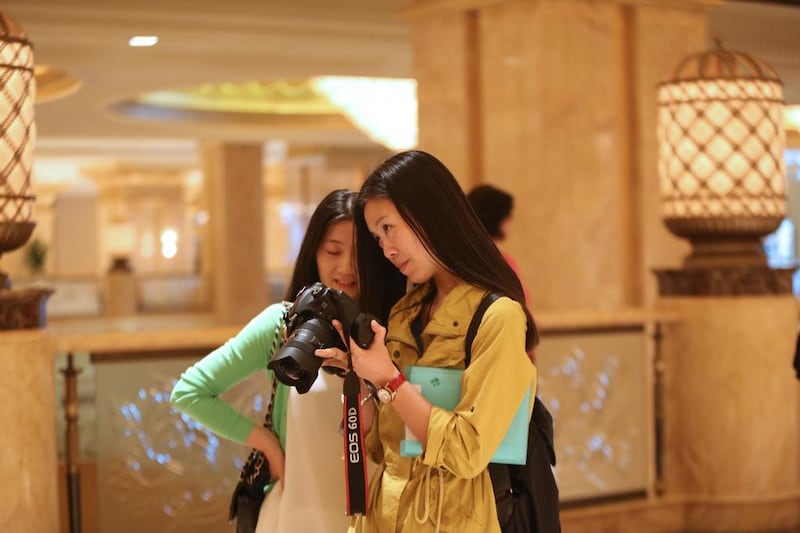Abu Dhabi expects to attract more visitors this year by focusing on its top source markets, including India and China, after achieving 8 per cent growth last year, according to the Abu Dhabi Tourism and Culture Authority (TCA Abu Dhabi).
During 2016, 4.4 million visitors checked into hotels in the emirate compared with 4.1 million the year before, TCA Abu Dhabi said on Wednesday.
Average stay was 2.73 nights, down from the 2.98 nights in 2015.
India, China, Saudi Arabia, the US, the UK and Germany are Abu Dhabi’s focus markets this year, based on flight connections to and from the emirate and forecast arrival numbers. The TCA has 11 offices worldwide that help in its marketing campaign.
“With this focus and by aligning our events and experiences with the markets, [such as holding events related to Bollywood or celebrating Diwali and Indian Independence Day for the Indian tourists], we expect better results this year,” said Sultan Al Dhaheri, the acting executive director for the tourism sector at TCA Abu Dhabi. “With the Louvre opening this year, Warner Bros [theme park on Yas Island] next year and Sea World coming up, Abu Dhabi is becoming an international tourist destination.”
India was the largest overseas market last year, with guest numbers growing 15 per cent to more than 323,300 guests.
“We had a bit of a blip in November due to demonetisation in India, but it was corrected in December and I expect by March we would be on a roll because the Indian market is resilient,” said Bejan Dinshaw, TCA’s country manager for India. “We expect a 15 to 16 per cent growth in the tourist numbers this year.”
The latest data from Abu Dhabi Airports on Wednesday showed that 4 million passengers flew to India from the capital’s main airport last year, a rise of 13.3 per cent.
Around 24.48 million passengers went through Abu Dhabi International in 2016, up 5.1 per cent. Etihad Airways accounted for 76 per cent of traffic at the airport last year. Between India’s Jet Airways and Etihad, there are about 300 direct flights a week from 15 Indian cities to Abu Dhabi. For hotel guests, the UK was the second-biggest source market last year with 238,167 guests, a 3 per cent increase, while 25,032 guests came from Ireland, an increase of 0.7 per cent.
“We hope to maintain the growth rate as last year was a challenging one with the value of the pound going down, and strong competition in the region,” said Nabeel Mahmoud Al Zarouni, the UK country manager.
TCA’s presence on microblogging sites such as Weibo and Wechat, and a visa-on-arrival scheme for Chinese visitors has catapulted China to the third place, with a 31 per cent rise in the number of guests to 231,916 tourists.
Air traffic to East Asia is expected to rise with Etihad Airways introducing 299-seat Dreamliners on daily year-round routes to Beijing, Shanghai and Seoul from March.
Tourists from within the UAE comprised one-third of all hotel guests, while Saudi Arabia was the largest regional market.
The tourism market from Russia and the Commonwealth of Independent States (CIS) is expected to grow, with a focus on the mid-market segment as the number of seats between the region and Abu Dhabi is not forecast to increase this year. “Our challenge is not the political situation or currency fluctuations, but we lack enough direct flights from our countries to Abu Dhabi,” said Grigoriev Edward, the country manager for Russia and the CIS. “Around 80 per cent of the clients coming to Abu Dhabi go through Dubai.”
There are about 32,000 seats a week from Russia and the CIS to Dubai, whereas there are only 1,800 seats a week between the region and Abu Dhabi, he said.
The CIS market accounted for 77,000 tourists last year, up 3 per cent, with 22,000 guests from Russia, which was down by 7 per cent. Tourists from Russia and the CIS stayed the longest at about five nights per visit.
Abu Dhabi had last year 30,000 rooms from 169 hotels and hotel apartments, a 3 per cent year-on-year increase. It has 10,000 more rooms in the pipeline in the next five years.
Such a robust pipeline is putting pressure on occupancy and rates. Abu Dhabi hotels’ average occupancy rate dropped by 3.6 per cent last year compared to the previous year to 71.7 per cent, while the average room rate declined 9.9 per cent for the same period to Dh467.49, according to the research firm STR.
ssahoo@thenational.ae
Follow The National's Business section on Twitter






